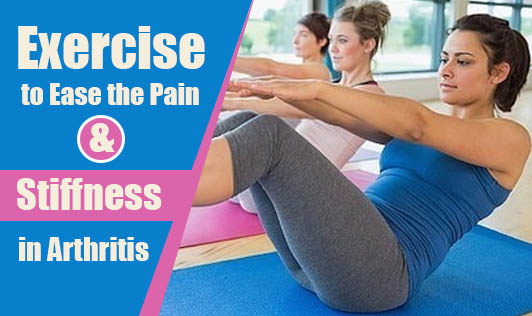Exercise is vital for people with arthritis, as it increases strength and flexibility of the muscles, reduces joint pain, and helps to combat fatigue. It also helps them reduce weight and improves their quality of life. Here are 3 types of exercise that will help you deal with arthritis. Make sure you create a workout program that includes a balance of these:
• Range-Of-Motion Exercises: Include exercise like stretching every alternate day for normal joint movement, maintaining flexibility, and relieving stiffness.
• Strengthening Exercises: Include exercises like weight training, resistance exercises, body weight exercises etc. to increase muscle strength. Muscle strength exercises will also help you support and protect arthritis-affected joints. Try to practice these exercises every alternate day, unless you have severe pain or swelling in your joints.
• Aerobic Exercises: Include aerobics like bicycle, walking, or swimming to improve your cardiovascular fitness, reduce weight, and relieve pressure and inflammation in the joints. Include 20 to 30 minutes of aerobic exercises at least 3 times a week, unless you have severe pain or swelling in the joints.
How to Start:
Always begin with easy, low impact exercises and as you become more comfortable progress to more advanced exercises. Start with simple water exercises and progress to walking or cycling. Always check with your doctor, if the exercise is safe for you before starting off a regimen.
Things to Remember:
• Move your joints daily to avoid stiffness and loss of joint movement.
• Exercise regularly on both good days as well as bad days. You can modify and decrease the intensity of your exercise on days when you're experiencing more pain than usual.
• Always move your inflamed joints gently in its range of motion.
• Do not go overboard with exercise. If you feel pain, stop immediately. This only applies to pain that is different from normal arthritis discomfort. Pain is the body's way of telling you that something is wrong.
• If you get tired, take rest for a few minutes and then continue.
• Always begin with slow warm up exercises to prevent stress on joints.
• Try your best to achieve a full complete motion until you feel a slight stretch. Do not force yourself to complete the move, go only as far as you feel comfortable.
• Do your exercise at your own pace in a slow and steady motion.
• You can use free weights, exercise machines, elastic bands, and water exercises for strength training. However make sure that your posture and positioning is correct to avoid more pain, muscle tear, and joint swelling.
• Get in touch with your doctor in case the pain lasts for more than 1 hour.
